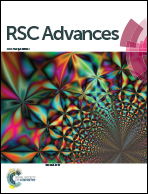Crystallization and temperature-dependent structure deflection of C6mimBr ionic liquid intercalated in LAPONITE®†
Abstract
The physicochemical properties of large molecules confined in nanopores are expected to be different from those of the bulk. This study investigates the cation–anion relative position and the molecular orientation of the 1-hexyl-3-methylimidazolium bromide (C6mimBr) ionic liquid intercalated in LAPONITE® by a temperature-dependent X-ray absorption fine structure (XAFS) and some traditional methods (TEM, DSC, XRD, and IR). DSC and TEM analyses revealed the formation of C6mimBr crystals intercalated in LAPONITE®. The XAFS and XRD analyses at ambient temperature revealed that an ordered monolayer structure, with C6mim+ cations intercalated in the interlayer nanospace and Br located on the edge of the LAPONITE®, was formed when ILs were intercalated in LAPONITE®. The results also demonstrated that the enhanced interactions, the formed hydrogen bonds, as well as the ordered monolayer arrangement induced the formation of C6mimBr crystals when intercalated in LAPONITE®. In situ XAFS analysis with a combination of XRD patterns at varied temperatures revealed that the structure orientation of the intercalated C6mim+ cations tends to deflect and maintain the ordered monolayer arrangement with the elevation of temperature. The ordered crystal structure still exists at 120 °C and disappears at a higher temperature.


 Please wait while we load your content...
Please wait while we load your content...